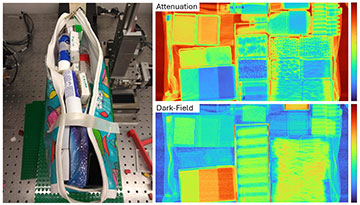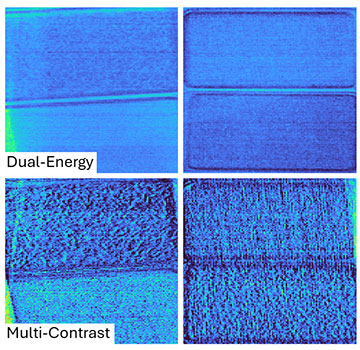
Threatening materials hidden in bags and other complex scenarios can be detected more reliably by a prototype X-ray scanner that captures phase-based images in addition to standard attenuation data. [IMAGE: Thomas Partridge, University College London]
Researchers from the UK and Germany have shown that dangerous materials hidden inside a bag can be detected with a prototype scanner that acquires six distinct X-ray images at the same time. By combining the multi-channel X-ray data with machine-learning methods that are widely used to classify different materials, the system can detect concealed explosives with a near-perfect success rate of 99.68% (Optica, doi: 10.1364/OPTICA.507049).
Detecting threats with edge illumination
Standard X-ray machines measure the loss in intensity once the radiation has passed through the sample, often capturing images at two different energies to distinguish between light and heavy objects. However, these dual-energy systems struggle to separate materials with a similar weight and composition, which makes it difficult to pick out explosives and other threat materials from everyday items that are typically packed in a bag.
In contrast, the new scanning system complements the attenuation data with phase-based images produced using a technique called edge illumination. To achieve the phase sensitivity, a mask placed before the sample creates a series of X-ray beamlets on the sub-pixel scale. Attaching another mask to the front of the detector then makes it possible to measure the refraction of the X-ray beamlets and to produce a dark-field image from their scattering behavior at ultrasmall angles.

The new technique combines conventional X-ray attenuation images at various X-ray energies (top) with X-ray phase information, which consists of refraction and dark-field channels, as shown in the example composite image on the bottom. [IMAGE: Thomas Partridge, University College London]
The edge-illumination technique also offers access to attenuation data at a third, much higher energy level, while the researchers also acquired dark-field images at two different spectral energies. This yields six channels of complementary imaging information that enables materials with a similar elemental composition to be detected, and in some cases identified, from differentiating features such as texture and grain size. Applying machine-learning techniques to these complex experimental datasets makes it quicker and easier to detect subtle differences in material properties.
Real-world tests
To test the approach in a range of real-world imaging scenarios, both dangerous and benign materials were concealed in bags and obscured by cluttering objects that are commonly found in carry-on luggage, such as face wipes, brushes and socks. From almost 1,200 test scans, the technique correctly detected the explosives in more than 300 cases, failing to spot them on just one occasion.
Translating this prototype into a commercial setting will require more work to speed up the scanning process, as well as more extensive testing to confirm the robustness of the technique. The researchers are also keen to explore the potential of the approach in other applications, particularly in medical imaging for discriminating between healthy and diseased tissue.
